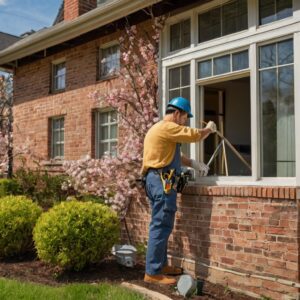
As the seasons change, our thoughts turn to spring and renewal. We think about cleaning out the attic, power washing the deck, and reorganizing the garage.
But as we’re focusing on cosmetic fixes for our homes, it’s easy to overlook one crucial aspect of home maintenance: safety.
A well-maintained home is not only a haven from the elements but also an essential hub for your family. However, with spring in full swing comes new risks and challenges that can put you and loved ones at risk.
In order to maintain energy efficiency while preventing costly repairs down the road, there’s more to a thorough spring inspection than meets the eye.
A comprehensive home assessment helps prevent issues such as mold growth caused by excessive moisture, carbon monoxide poisoning from faulty HVAC systems or generators and ensuring your plumbing is ready for warmer temperatures.
To help you stay on top of necessary tasks and avoid costly surprises, we’ll be covering five essential tasks to include in your spring home inspection checklist.
Beating The Heat – Identifying Hidden Dangers
As spring arrives, it’s time to tackle that home inspection checklist and ensure your residence is safe and energy-efficient. Beating the heat starts with identifying potential dangers that could lead to costly repairs or even safety hazards.
One essential task on your list should be inspecting roof damage caused by weather conditions like hail, high winds, or heavy snow. Look for missing, damaged, or loose shingles, curled or buckled sheets of roofing material and signs of wear around chimneys, vents and skylights. Fix these issues promptly to prevent water intrusion and costly repairs down the line.
Another critical task is inspecting electrical components in your home’s attic. Check that old wiring isn’t frayed, damaged or exposed, as this can lead to overheating and fires. Make sure all connections are secure, cables are not pinched or compressed, and outlets cover gaps left by doors.
Inspect windows for proper sealing and weather stripping around their frames to prevent heat loss in the winter months. Check that window sashes operate smoothly and aren’t jammed, as this can cause them to break easily if a strong gust of wind hits your home. Inspect door sweeps under doors, ensure they are securely attached, and check seals for cracks or gaps.
When it comes to plumbing systems like pipes in the crawl space, be on the lookout for leaks around joints and connections that may indicate water damage. Also inspect frozen or damaged downspout extenders to prevent ice dams from forming at your home’s exterior walls.
Snagging the Perfect Seasonal Decorations
Floral arrangements: Spring is the ultimate flower lover’s paradise! Not only do fresh flowers add a pop of color and vibrancy to any room, but they can also create a sense of renewal and rejuvenation. Consider opting for blooms in pastel shades like pale pink or baby blue, which will subtly warm up your space without overwhelming it. You can opt for classic bouquets made with peonies and roses or mix things up by incorporating sunflowers into the arrangement.
Alternatively, try using fresh greenery like ferns or succulents as a centerpiece to bring in some natural beauty without committing to full-on flowers. Not only do they add an element of whimsy, but their delicate foliage will subtly purify the air and leave your home feeling fresher.
Pastel-colored accents: Spring is the perfect opportunity to inject some soft pastels into your decor and create a dreamy atmosphere. For those looking for DIY inspiration, consider adding warm candlelight or using vintage postcards as decorative wall art. You can also repurpose old t-shirts or scarves by dyeing them in vibrant colors and hanging them on clotheslines (or even reusing the hanger to add some greenery).
If you’re short on time but still want to get creative, grab a pack of pastel markers and have fun customizing your furniture with colorful doodles. From there, it’s easy to turn any space into a whimsical wonderland.
Seasonal greenery: As spring awakens the outdoors, it’s also an ideal time to bring in some fresh air (and plants!) indoors. Green walls are all the rage this season if you don’t have a full wall to dedicate, even adding one or two potted plants can make an impact.
You should consider opting for low-maintenance houseplants that not only purify your home but also serve as decorative statement pieces. With spring in mind, some great options include delicate orchids and bold peace lilies. They’ll add a touch of natural elegance without demanding too much maintenance.
Spring-themed doormat: Why just stop at flowers when you can make a stylish entrance with colorful welcome mats? They’re the perfect way to greet guests as spring arrives, and are an inexpensive way to bring some seasonal cheer into your home.
Airy textiles for your outdoor space:It’s not easy getting started on that porch but using vibrant colors like yellow and orange will immediately brighten up any area.
Whether you choose a pastel pink throw or set the scene with spring-green pillows, you can create a visually appealing atmosphere in no time.
Taming the Beast of Mold and Mildew


Dampness, mold, and mildew can be detrimental to your home’s integrity. To tackle this issue effectively in your spring home inspection checklist, focus on inspecting for water leaks or condensation issues that may lead to dampness in walls and ceilings.
When it comes to identifying the root cause of these problems, think of water stains on the ceiling as a warning sign – they often indicate excessive moisture buildup. Check for warping woodwork, black mold growth on surfaces, or musty odors in insulation materials. If you notice any of these signs, it’s likely that your home needs some attention.
To tackle mold and mildew effectively on your own, start by inspecting the attic insulation. Look for visible signs of moisture or debris accumulation within the insulation materials themselves (think black spots). Ensure adequate ventilation is present to prevent further damage. You can accomplish this with simple DIY solutions like installing a whole-house fan or recommending an air conditioning system with built-in dehumidification capabilities.
Additionally, inspect your plumbing system’s drainage and fix any leaks promptly. Don’t underestimate the power of clogged gutters – if not cleaned regularly, they can lead to water accumulation around windows and doors. Look for narrow crevices between window frames or door sweeps where air may be leaking in, causing damage.
Some common areas prone to moisture accumulation are crawlspaces and basement areas. Ensure that these zones receive proper ventilation by installing a subfloor vapor barrier or upgrading the insulation material. Weatherstripping around doors and windows is another simple fix that can significantly reduce moisture entry points.
Lastly, check for any gaps or cracks in your attic’s electrical system boxes, as well as ensure your roof has a secure seal to prevent water damage from entering through soffits. When it comes to inspecting attics, consider adding lighting sources like LED lights that help you spot hidden issues more easily.
By tackling these common areas of moisture entry and incorporating practical solutions into your spring home inspection checklist, you’ll be well on your way to taming the beast of mold and mildew and creating a healthier living space.
Don’t Get Caught Slippin’ – Inspect Those Gutters!
Inspecting your gutters may seem like a trivial task, but its importance should not be underestimated. Gutter damage can have severe consequences on your home’s structure and integrity.
Signs of neglected gutters include sagging or missing sections that are as old as the hills literally! Over time, rust and corrosion creep in unnoticed, causing these structural issues. You may see that the gutters are sagging or missing sections due to animal damage, like a
squirrel-sized hole in your roof or walls.
Dirty or clogged gutters can result in costly repairs for things like damaged siding and roofing leaks. It’s time to get down and dirty with some gutter cleaning! Regular cleanings will keep your gutters flowing freely, reducing the risk of water accumulation that may cause erosion around your home’s foundation and compromise its structural integrity.
Are you ready to protect your home from water damage? Pests like birds or squirrels making their homes in your gutter system is a common problem. It can lead to costly repairs for things like damaged walls and floors, as well as compromised insulation, a major financial hit! Seal any holes or gaps in your roof or walls, remove food sources that attract pests.
Your gutters are like the unsung heroes of your home’s defense system; they work hard to keep water away from your foundation without complaint. Regular inspections can prevent these types of problems before they escalate into costly disasters. Schedule regular gutter cleanings and maintenance checks to keep them flowing freely, reducing the risk of damage and ensuring a watertight seal.
By inspecting your gutters regularly, you’ll be giving yourself some peace of mind that your home is secure for years to come, no more worrying about water damage or pest infestations. So here’s how it can all go wrong: neglect those gutters and risk costly repairs down the line! Don’t let this happen in your home – inspect them today.
Finding That Perfect Spring Tune-Up Partner
Don’t let your heating or cooling system sabotage your warm-weather comfort. A well-chosen service provider is crucial for maintaining a safe and energy-efficient home.
Finding that perfect spring tune-up partner can make all the difference in ensuring your home remains cozy during warmer months. When looking for a reliable service provider, consider factors beyond just price. NATE-certification is an important indicator of quality training from top manufacturers. This certification ensures technicians have received comprehensive education on heating and cooling systems.
A company’s reputation is also vital to gauge their reliability and customer service skills. Research previous customers’ reviews to understand how they’ve responded to issues or exceeded expectations in the past. For instance, a notable review states: “We were surprised by the prompt response to our emergency situation. Our technician arrived promptly and resolved issues efficiently.” This kind of responsiveness can be invaluable for ensuring your system is performing at its best.
When asking about their spring tune-up services, consider specific questions like:
- What types of systems do they service? (heating and cooling)
- How many years ago was the last time they replaced your furnace/AC unit?
- Are there any special precautions or requirements for certain equipment or areas?
When choosing a service provider, consider how long it takes to complete their services and any additional fees for extra work. Also think about warranty options: A reputable company should stand behind its work with comprehensive warranties that protect you financially in case anything goes wrong.
Finally, look at ongoing maintenance contracts or recommendations which can save money long-term. Some companies offer affordable annual agreements (e.g., $200- $400 per year) to ensure your system is always ready for the warmer months ahead.
A reliable spring tune-up partner will have expertise and equipment to identify potential issues before they become major problems, keeping your home safe and energy-efficient throughout the warmer seasons.
Your Home’s Secret Stash for Pest Control
When spring arrives, don’t forget about those pesky critters hiding in secret areas around your home. A thorough inspection is key to preventing unwanted guests from making themselves at home.
You should never ignore the area around windows and doors: These entry points are perfect habitats for unwanted insects like ants, silverfish, or even rodents. Look closely at any gaps or cracks in window and door frames, as well as their surroundings. For instance, consider sealing those pesky gaps with caulk made from natural materials like beeswax and pine resin.
In the “windows” section of your home’s perimeter:
- Inspect for signs of pest activity such as tiny holes or tears in screens that could be allowing unwanted critters inside.
- Take note of any worn-out weatherstripping, which can provide an easy entry point for pests like mice and other rodents. Replace it with new weatherstripping made from durable materials like silicone.
As you inspect the area around your vents or chimneys:
You may also want to consider checking these hard-to-reach spaces because they’re ideal hideouts for unwanted critters such as bats, rodents, and even snakes!
- Inspect insulation in attics carefully.
- Look for any signs of pest activity like droppings or nesting materials hidden behind storage containers. The attic can quickly become a hotbed for pest infestations.
Don’t forget about your garage: This is often an overlooked area that can rapidly turn into a hotspot for pest activity:
Regular cleaning up debris, trimming back plants, and sealing off holes in fences are effective measures to prevent unwanted critters at bay.
Getting Ready for Storm Season, Safety First!


Inspect Gutters and Downspouts
Regular gutter cleaning is crucial for your home’s exterior safety. A clean system helps direct water away from the foundation, reducing erosion risks like soil displacement or basement flooding. It also prevents clogging, which can cause water to back up into your gutters and downspouts, leading to damage.
Take a few minutes to climb up onto ladders and inspect your gutters from top to bottom. Remove any debris that’s accumulated over winter, such as leaves, twigs, or pine needles. This will help prevent clogging and ensure water flows freely through the system.
Beyond preventing clogging and pest infestations like mosquitoes (remember: clean gutters can reduce mosquito breeding sites!), you should also check for damaged or loose screws holding your gutter hangers in place.
Trim Tree Branches
Trim tree branches that are close to your home, power lines, or other overhead structures. This will minimize the risk of branch damage from high winds and help prevent power outages. When trimming branches near power lines, it’s a good idea to hire an arborist if you’re unsure about how to do it yourself.
Before pruning tree branches that are close to your home, consider removing dead or weak limbs (or even entire trees) by hiring a professional arborist. This will help prevent damage from falling branches and reduce the risk of costly repairs down the line.
Secure Outdoor Items
Secure all outdoor items that could become projectiles in strong winds, such as patio furniture, trash cans, loose debris, heavy outdoor decorations like plants or planters, bike racks with wobbly wheels. The goal is to prevent damage to your home’s exterior and reduce the risk of injury from flying objects.
Don’t just secure patio furniture; also make sure that other items like garden gnomes or outdoor lighting fixtures are tied down tightly. This simple step can save you a lot of stress (and financial losses) during future storms.
Inspect Roofing
A damaged roof can lead to costly repairs after a storm. Inspect your roof for signs of wear around chimneys, vents, and skylights due to the increased risk of leaks from heavy rainfall. Look for:
- Asphalt shingles that are curled or missing.
- Metal flashing that’s cracked or rusted.
- Gutter seams that have separated from each other.
Keep an eye on these areas during your home inspection because water damage can be especially costly if left unchecked, leading to structural problems and a host of additional repair costs.
Prepare Heating System
Prepare your heating system for extreme weather conditions. Change the air filter in your furnace or AC unit to ensure optimal performance and reduce energy bills.
This simple maintenance will not only save you money but also help maintain indoor comfort levels during hot summer days or cold winter nights, a must-have when it comes to storm season!
By following these tasks, you can help protect your home from storm damage, prevent costly repairs, and enjoy peace of mind knowing that your residence is safe for yourself and loved ones.
Navigating The Great Indoors to Ensure Proper Ventilation
Spring cleaning isn’t just about decluttering your home; it also requires checking for potential issues before they become major problems. One crucial aspect is proper ventilation, especially when temperatures rise. As mold and mildew can thrive in warm conditions, inspect your crawl spaces and attics to ensure there are no signs of poor airflow.
When inspecting your home in the spring, focus on areas that are prone to moisture accumulation:
- You notice water damage or stains:
- Inspect your roof for warping wood or black mold growth.
- Check gutters for debris and clog prevention tools like gutter guards.
- Look for signs of a leaky roof, such as missing shingles or water-stained insulation.
Check the attic to ensure that your ventilation system is working properly. Make sure there are no signs of damage or blockages in areas like soffit vents and ridge vents.
- Are you ready for some unexpected visitors this spring? Mold and mildew can appear without warning, especially near windows, doors, and ducts with gaps.
- Check the attic to ensure proper ventilation; if it’s not working correctly, consider hiring a professional.
- Consider using an air purifier or dehumidifier to combat musty smells.
You find dust buildup:
Dusty surfaces can be like unwanted roommates; they’re always there and take up space.
To get rid of them, try vacuuming with a HEPA-filtered vacuum and wiping down surfaces with a damp cloth.
- Check door and window seals: Make sure they are functioning properly to prevent air leaks.
- Apply weatherstrip sealant around windows to keep warm air in and cold air out.
- Consider upgrading old or worn-out seals for better insulation.
Regularly cleaning range hood filters can help reduce dust buildup. Here’s a quick fix:
- Clean oven vent filter: Use a vacuum cleaner with a soft brush attachment or replace it every 6-12 months to maintain airflow.
Additional Tips:
- Check your ventilation system regularly and schedule maintenance.
- Keep windows open during the day for cross-ventilation on warm days.
- Try using natural products like baking soda to absorb moisture.
A Fresh New Look at Smoke and Carbon Monoxide Detectors


Smoke and carbon monoxide detectors are often overlooked aspects of home safety, but they play a crucial role in preventing accidents. Installing smoke detectors strategically throughout your home can save lives by detecting potential fire hazards. Consider installing them outside bedrooms and inside each room where cooking occurs, such as kitchens and laundry rooms.
Regularly tested smoke detectors (at least once a month) will help identify any issues before they become major problems. For instance, kitchen stoves or water heaters that don’t function properly can trigger an alarm in minutes often before you even know something is wrong. In addition to this, place them near sleeping areas and garages where cooking appliances are more likely to be used.
Smoke detectors come with sensors designed to pick up on changes in temperature and pressure, alerting you if any anomalies may indicate an impending fire hazard. This can provide several minutes of time for you and your family members to escape safely through the doors or windows.
Carbon monoxide is a silent killer that affects anyone, regardless of their age. Regularly installed carbon dioxide detectors can save lives by detecting potential hazards caused by faulty fuel-burning appliances or poorly ventilated areas such as attached garage apartments where vehicles are often parked overnight. This device helps to protect households from CO poisoning risks.
In addition to installing smoke and carbon monoxide detectors, don’t forget the importance of maintaining them too: ensure that all devices have working batteries (or replace them annually) as specified by the manufacturer, inspecting frequently for signs of wear or malfunction potentially preventing entire household disasters.
Assessing Fire Exits Before They Become Necessary
Great homes are only as safe as their weakest link. Taking proactive steps to ensure that fire exits remain accessible and usable is crucial, not just for compliance purposes but for the well-being of every resident.
The absence of a clear escape route can lead to catastrophic consequences. When a fire breaks out in your home’s basement or garage, every second counts. By regularly inspecting and maintaining these areas, you can ensure that occupants have a safe way out in an emergency.
Assessing fire exits is not just about identifying hazards; it’s also about recognizing opportunities for improvement.
Regularly clear obstructions from escape routes to keep them accessible during emergencies.
Prioritize this task before they become necessary by incorporating it into your seasonal home maintenance routine.
Don’t wait until a life-changing event forces you to take action. Take decisive steps today to secure the safety and well-being of yourself and your loved ones.


